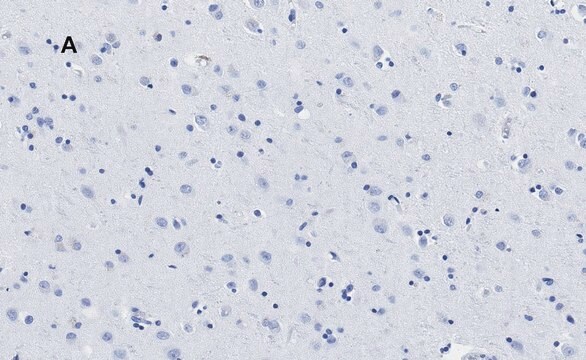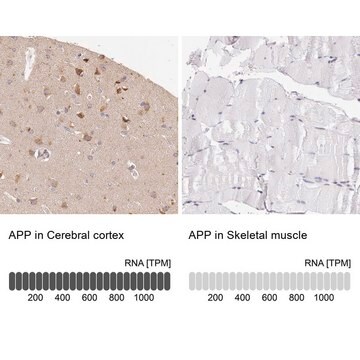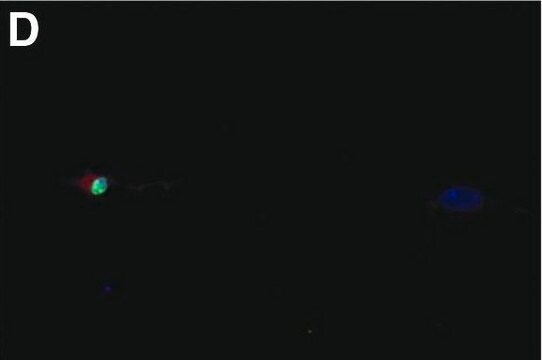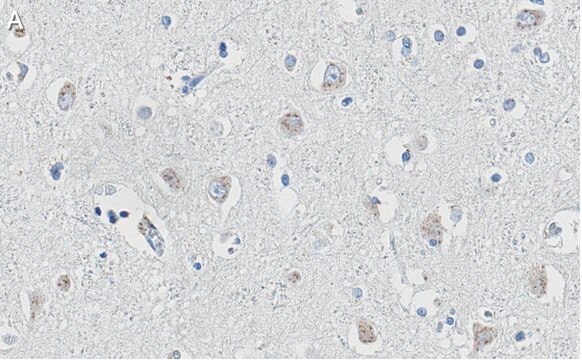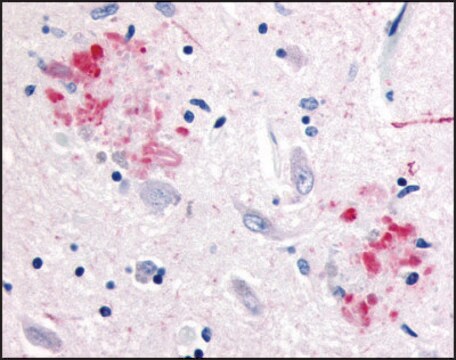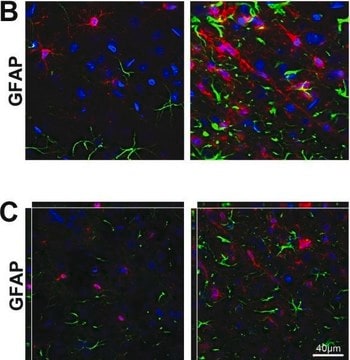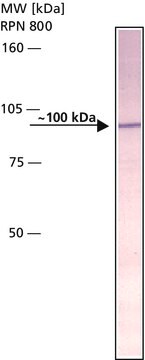MAB343
Anti-APP Antibody, APP 643-695 CT fragment, clone 2.F2.19B4
ascites fluid, clone 2.F2.19B4, Chemicon®
Sinônimo(s):
APP, Jonas clone
Faça loginpara ver os preços organizacionais e de contrato
About This Item
Código UNSPSC:
12352203
eCl@ss:
32160702
NACRES:
NA.41
Produtos recomendados
fonte biológica
mouse
Nível de qualidade
forma do anticorpo
ascites fluid
clone
2.F2.19B4, monoclonal
reatividade de espécies
rat, human
fabricante/nome comercial
Chemicon®
técnica(s)
immunohistochemistry: suitable (paraffin)
western blot: suitable
Isotipo
IgG1
nº de adesão NCBI
nº de adesão UniProt
Condições de expedição
dry ice
modificação pós-traducional do alvo
unmodified
Informações sobre genes
human ... APP(351)
Especificidade
Reacts with intact full-length Alzheimer precursor protein (APP) and selectively with the cytoplasmic carboxyl fragment of APP 643-695. Epitope has reportedly been mapped in this paper http://www.impub.co.uk/abs/W386.html
Imunogênio
Carboxyl fragment of APP 643-695 / Jonas.
Epitope: APP 643-695 C-terminal fragment
Aplicação
Immunohistochemistry on paraffin sections: 10-20 μg/mL * See protocol below.
Western blot: 10 μg/mL
Optimal working dilutions must be determined by end user.
APPLICATION NOTES FOR MAB343
IMMUNOHISTOCHEMISTRY
1) Prepare paraformaldehyde-fixed paraffin sections. Wash twice for 5 min in xylene to deparaffinize. Wash sections for 5 min in a descending series of alcohol solutions (100%, 96%, 90%, 80%, 70%, 50%, 30%).
2) Wash sections 3 times in distilled water.
3) Wash in TBS (50 mM Tris-HCl, 150 mM NaCl, pH 7.6). To block endogenous peroxidase wash with methanol containing 0.6% H2O2 (v/v) and 10 % horse serum (v/v) for 5 min at room temperature.
4) Wash sections for 5 min in TBS.
5) Incubate sections with MAB343 (diluted in TBS containing 10% horse serum (v/v)) overnight at +4°C or for 2 hours at 37°C in a humid chamber.
6) Wash sections 3 times in TBS for 5 min..
7) Detect with standard secondary antibody detection system (PAP, ABC, etc.).
8) Wash sections in TBS.
9) Embed sections and examine.
Western blot: 10 μg/mL
Optimal working dilutions must be determined by end user.
APPLICATION NOTES FOR MAB343
IMMUNOHISTOCHEMISTRY
1) Prepare paraformaldehyde-fixed paraffin sections. Wash twice for 5 min in xylene to deparaffinize. Wash sections for 5 min in a descending series of alcohol solutions (100%, 96%, 90%, 80%, 70%, 50%, 30%).
2) Wash sections 3 times in distilled water.
3) Wash in TBS (50 mM Tris-HCl, 150 mM NaCl, pH 7.6). To block endogenous peroxidase wash with methanol containing 0.6% H2O2 (v/v) and 10 % horse serum (v/v) for 5 min at room temperature.
4) Wash sections for 5 min in TBS.
5) Incubate sections with MAB343 (diluted in TBS containing 10% horse serum (v/v)) overnight at +4°C or for 2 hours at 37°C in a humid chamber.
6) Wash sections 3 times in TBS for 5 min..
7) Detect with standard secondary antibody detection system (PAP, ABC, etc.).
8) Wash sections in TBS.
9) Embed sections and examine.
Research Category
Neuroscience
Neuroscience
Research Sub Category
Neurodegenerative Diseases
Neurodegenerative Diseases
This Anti-APP Antibody, APP 643-695 C-terminal fragment, clone 2.F2.19B4 is validated for use in IH(P), WB for the detection of Alzheimer Precursor Protein.
forma física
Liquid.
Unpurified
Armazenamento e estabilidade
Maintain lyophilized material at +2–8°C for up to 12 months. After reconstitution maintain frozen at -20°C in undiluted aliquots for up to 6 months. Avoid repeated freeze/thaw cycles.
Nota de análise
Control
Brain
Brain
Outras notas
Concentration: Please refer to the Certificate of Analysis for the lot-specific concentration.
Informações legais
CHEMICON is a registered trademark of Merck KGaA, Darmstadt, Germany
Exoneração de responsabilidade
Unless otherwise stated in our catalog or other company documentation accompanying the product(s), our products are intended for research use only and are not to be used for any other purpose, which includes but is not limited to, unauthorized commercial uses, in vitro diagnostic uses, ex vivo or in vivo therapeutic uses or any type of consumption or application to humans or animals.
recomendado
Nº do produto
Descrição
Preços
Código de classe de armazenamento
10 - Combustible liquids
Classe de risco de água (WGK)
WGK 1
Ponto de fulgor (°F)
Not applicable
Ponto de fulgor (°C)
Not applicable
Certificados de análise (COA)
Busque Certificados de análise (COA) digitando o Número do Lote do produto. Os números de lote e remessa podem ser encontrados no rótulo de um produto após a palavra “Lot” ou “Batch”.
Já possui este produto?
Encontre a documentação dos produtos que você adquiriu recentemente na biblioteca de documentos.
Eun Mi Hwang et al.
Bioorganic & medicinal chemistry, 16(14), 6669-6674 (2008-06-21)
In order to access beta-secretase (BACE1), and enzyme strongly implicated in the cause of Alzheimer's disease, inhibitors must possess sufficient lipophilicity to traverse two lipid bilayers. Current drug candidates, which are almost totally peptide-derived, are thus inefficient because cell permeability
Gregory D Van Vickle et al.
Biochemistry, 46(36), 10317-10327 (2007-08-21)
We investigated the morphology and biochemistry of the amyloid-beta (Abeta) peptides produced in TgCRND8 Tg mice carrying combined amyloid precursor protein (APP) Swedish (K670M/N671L) and Indiana (V717F) mutations. Histological analyses employing amyloid-specific staining and electron microscopy revealed that the TgCRND8
Effects of peptides derived from BACE1 catalytic domain on APP processing.
Seung Woo Yeon, Yong-Jin Jeon, Eun Mi Hwang, Tae-Yong Kim
Peptides null
A TAG1-APP signalling pathway through Fe65 negatively modulates neurogenesis.
Quan-Hong Ma, Toshitaka Futagawa, Wu-Lin Yang, Xiao-Dan Jiang, Li Zeng, Yasuo Takeda et al.
Nature Cell Biology null
P Ponte et al.
Nature, 331(6156), 525-527 (1988-02-11)
The amyloid proteins isolated from neuritic plaques and the cerebrovasculature of Alzheimer's disease are self-aggregating moieties termed A4 protein and beta-protein, respectively. A putative A4 amyloid precursor (herein termed A4(695] has been characterized by analysis of a human brain complementary
Nossa equipe de cientistas tem experiência em todas as áreas de pesquisa, incluindo Life Sciences, ciência de materiais, síntese química, cromatografia, química analítica e muitas outras.
Entre em contato com a assistência técnica
